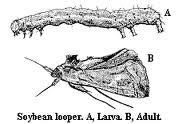Soybean Looper
go.ncsu.edu/readext?202033
en Español / em Português
El inglés es el idioma de control de esta página. En la medida en que haya algún conflicto entre la traducción al inglés y la traducción, el inglés prevalece.
Al hacer clic en el enlace de traducción se activa un servicio de traducción gratuito para convertir la página al español. Al igual que con cualquier traducción por Internet, la conversión no es sensible al contexto y puede que no traduzca el texto en su significado original. NC State Extension no garantiza la exactitud del texto traducido. Por favor, tenga en cuenta que algunas aplicaciones y/o servicios pueden no funcionar como se espera cuando se traducen.
Português
Inglês é o idioma de controle desta página. Na medida que haja algum conflito entre o texto original em Inglês e a tradução, o Inglês prevalece.
Ao clicar no link de tradução, um serviço gratuito de tradução será ativado para converter a página para o Português. Como em qualquer tradução pela internet, a conversão não é sensivel ao contexto e pode não ocorrer a tradução para o significado orginal. O serviço de Extensão da Carolina do Norte (NC State Extension) não garante a exatidão do texto traduzido. Por favor, observe que algumas funções ou serviços podem não funcionar como esperado após a tradução.
English
English is the controlling language of this page. To the extent there is any conflict between the English text and the translation, English controls.
Clicking on the translation link activates a free translation service to convert the page to Spanish. As with any Internet translation, the conversion is not context-sensitive and may not translate the text to its original meaning. NC State Extension does not guarantee the accuracy of the translated text. Please note that some applications and/or services may not function as expected when translated.
Collapse ▲Soybean Looper, Chrysodeixis includens (Walker)
Family: Noctuidae, Order: Lepidoptera
Biology: The defoliating soybean looper is a year-round resident of more southern areas, but it migrates into NC each year. The immigration pattern is typically along the coast from south to north and spreading inland. Coastal counties south of Cape Lookout have the highest likelihood of economic infestation, although in some years infestations may spread above the Albemarle Sound and inland to I-95. The moth is a dark brown robust moth with a small silver-white figure eight spot on each forewing. Larvae are green with whitish lines along the length of the body and three pair of fleshy prolegs. The body of the larvae is tapered from the rear (largest) forward to the head. Often the true legs and head are black. Larvae crawl with a distinct looping motion and may rest in this pose. The caterpillar favors the lower plant canopy and leaf underside, but will feed over the entire plant as defoliation progresses.
Injury and damage: This caterpillar is a voracious feeder and high-abundance populations can completely strip the foliage from fields; they do not feed on pods. Soybean looper moth populations peak in late August. Moths colonize soybean and cotton fields. High infestation is often associated with the removal of predators and parasites by insecticide use for corn earworm (bollworm) control. Also, research has shown that moths feeding on cotton nectaries develop and lay many more eggs, resulting in higher populations in the vicinity of cotton fields. Peak larval populations occur in September, mostly on later planted soybeans; as a result double crop soybeans are the most susceptible.
Insecticide management: Soybean looper was historically difficult to kill since most populations are resistant to pyrethroid insecticides. Due to their habit of staying low in the canopy, on the leaf underside, insecticide performance is often negatively affected by poor coverage. However, many of the newer chemistries (flubendiamide, indoxacarb and spinosyns), as well as carbamate insecticides are very effective at managing this insect.




